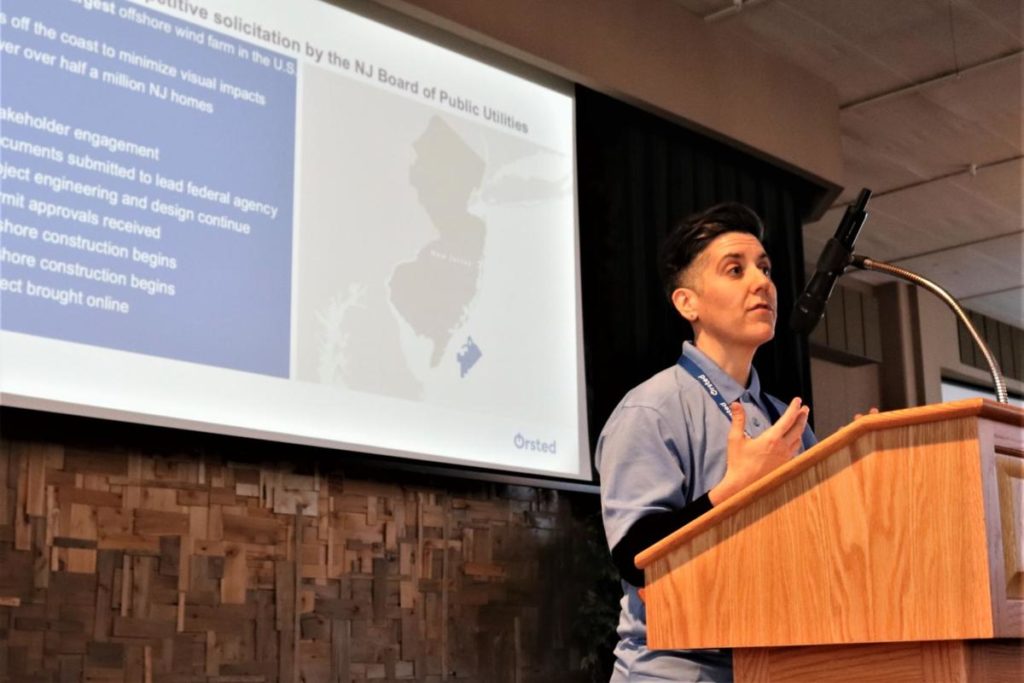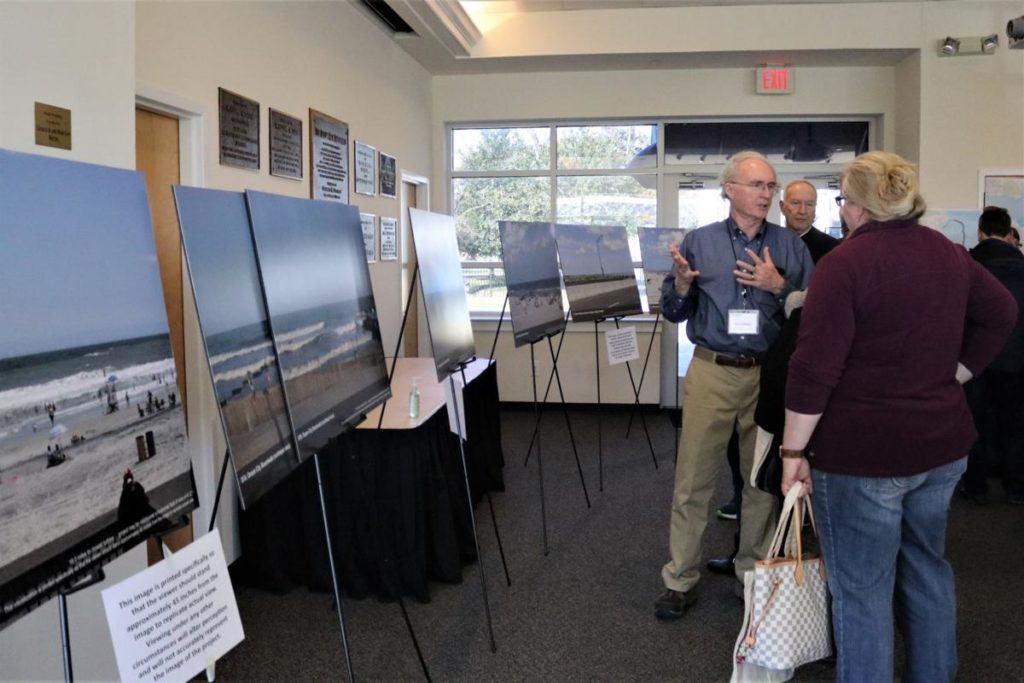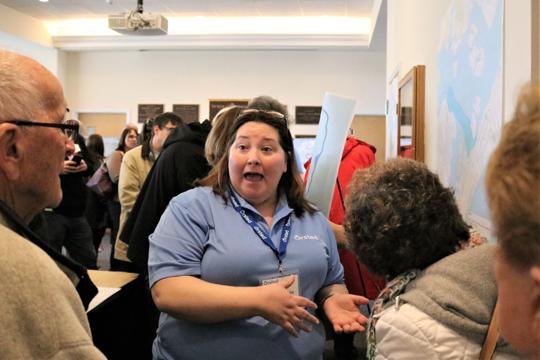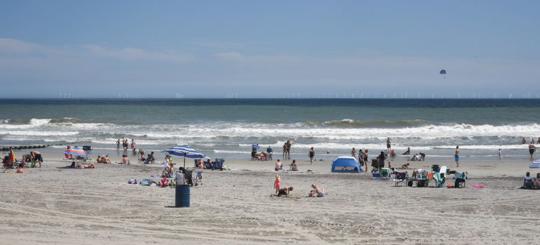
OCEAN CITY – Residents went to the Ocean City Tabernacle Feb. 8 to learn more about an offshore wind project that supporters see as a step away from fossil fuels for New Jersey.
Last year, Gov. Phil Murphy tapped Danish energy giant Orsted for the first step in a clean-energy plan that could power a half-million homes. The company has years of work ahead of it to get the needed permits for the project, Kris Ohleth, Orsted’s senior manager for government affairs, told about 75 people at the event. Plans call for the 1,100-megawatt project to start generating power by 2024.
First, the project, known as Ocean Wind, needs to build the infrastructure to bring that power into the energy grid, then build the collection of massive wind turbines about 15 miles off the coast of Atlantic and Cape May counties.
The turbine blades are proposed to have a radius of more than 720 feet, far larger than the boardwalk Ferris wheels in beachside amusement parks.
At the event, Orsted staff had renderings mounted on easels, showing what the planned turbines may look like from the beach on a clear day. The images show a gray line on the far horizon, as seen from the beach in Atlantic City.
After a brief introduction by Carol Beske, of ACT Engineers, and from Ohleth, those attending gathered in the lobby, where Orsted staff members set up tables to discuss various topics related to the project. Organizers said that gave residents a chance to ask detailed questions and express their concerns.

It also prevented residents from addressing all of those gathered at once.
“Don’t call this a town meeting,” said resident Bill Bradway to a reporter after the presentations. He had issues with several elements of the project, and does not believe it is the best option for power for the future, citing the massive investment in infrastructure and the current low cost of natural gas.
The wind turbines will end up in the trash at the end of their useful lives, he said, and he cited environmental issues with the construction and the manufacture of magnets needed for the turbines. Writer Chris Martin, in a piece posted by Bloomberg Feb. 5, reported that the turbine blades can be longer than the wing of a 747, can’t be recycled and are piling up in landfills.
Several residents had local concerns.
“One of the biggest concerns of the business people is that they’re going to be so ugly that nobody is going to want to come to Ocean City anymore,” Ocean City resident Todd Lukens told one of the staff members.
The first offshore wind project in the country, off Block Island in Rhode Island, has become a tourist attraction in its own right, said Orsted staff member Sarah Zappala. She told Lukens that visitors charter boats to visit the site.

Lukens later said he does not oppose the project, and believes that wind turbines will be needed as a power source for the future to reduce the amount of carbon released into the atmosphere. They will have to go somewhere, he said.
Other residents questioned the impact on wildlife. Also citing the Rhode Island project, Zappala said the base of the turbines act like artificial reefs, increasing the habitat and complexity of the underwater environment.
A study by the U.S. Fish and Wildlife Service found hundreds of thousands of birds are killed by wind turbines each year, based on the existing land-based wind farms.
Looking at the photo-like renderings of the offshore turbines, a woman asked what they would look like at night when they would need to be illuminated to prevent collisions from airplanes and boats. She was told by another staff member that Orsted requested special permission from the Federal Aviation Administration (FAA) to use a system that would only light the turbines when a plane was passing the wind farm.

Lights on the base of the structures would remain on for the safety of boat traffic, he said, but would not be visible from the beach because they would be beyond the horizon and obscured by the curve of the Earth.
Zappala discussed plans to bring power lines to shore from the turbines to connect with the power grid. Possibilities include running the lines under the street at 35th Street and across Ocean City, then under the bay to the former B.L. England generating station in Beesley’s Point, a coal-fired plant decommissioned last year.
Orsted plans to land some of the power at the former Oyster Creek nuclear power plant in Ocean County. The company is weighing options for where to bring lines in from the southern portion of the project, including in Atlantic City and at B.L. England. Company spokesman Gabe Martinez said no final decision has been made.
Ocean City Mayor Jay Gillian attended the meeting, but did not speak. Instead, Beske ran the event.
In introducing Ohleth, she described Orsted as the number one wind power producing company in the world, with multiple wind farms throughout Europe, as well as wind farms in Asia and the U.S.
Ohleth said she has supported wind energy throughout her life.
In brief comments, she said the company has 26 offshore wind projects, amounting to a third of the offshore wind power generation in the world. The company received the award for the project in June. She said the project would be an economic benefit to the state. It would cost ratepayers throughout the state an average of $1.46 a month.
Murphy has set a goal of 100% renewable energy for New Jersey by 2050.
The total cost of the project is expected to be about $695 million, she said. Proponents of the project, including Murphy, expect the construction and operation to pay off in local jobs. Next year, New Jersey expects to seek proposals for a contract for another 1,100 megawatts of wind power, with a third phase planned after that.
To contact Bill Barlow, email bbarlow@cmcherald.com.
This story was produced in collaboration with the New Jersey Sustainability Reporting Hub project. It was originally reported by Bill Barlow for the Cape May County Herald, and may be re-distributed through the Creative Commons License, with attribution.
